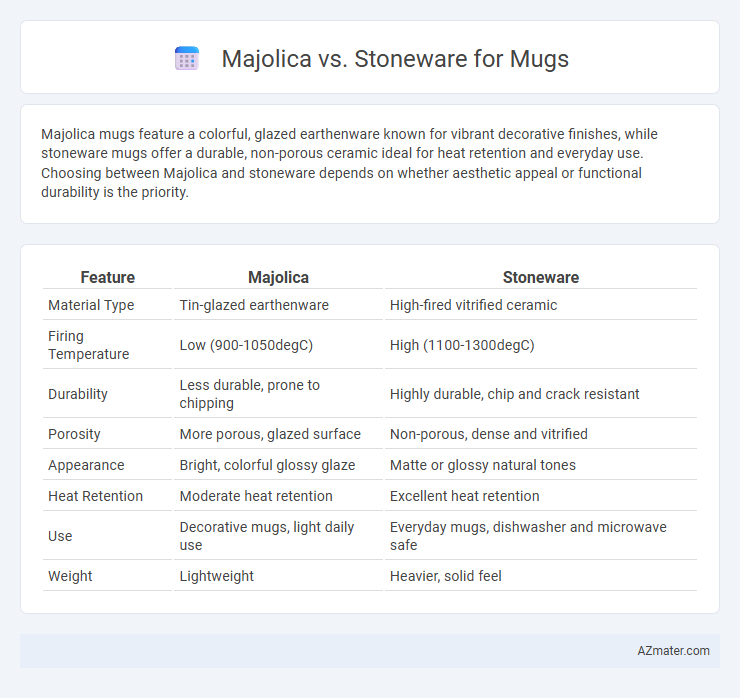Majolica mugs feature a colorful, glazed earthenware known for vibrant decorative finishes, while stoneware mugs offer a durable, non-porous ceramic ideal for heat retention and everyday use. Choosing between Majolica and stoneware depends on whether aesthetic appeal or functional durability is the priority.
Table of Comparison
| Feature | Majolica | Stoneware |
|---|---|---|
| Material Type | Tin-glazed earthenware | High-fired vitrified ceramic |
| Firing Temperature | Low (900-1050degC) | High (1100-1300degC) |
| Durability | Less durable, prone to chipping | Highly durable, chip and crack resistant |
| Porosity | More porous, glazed surface | Non-porous, dense and vitrified |
| Appearance | Bright, colorful glossy glaze | Matte or glossy natural tones |
| Heat Retention | Moderate heat retention | Excellent heat retention |
| Use | Decorative mugs, light daily use | Everyday mugs, dishwasher and microwave safe |
| Weight | Lightweight | Heavier, solid feel |
Introduction to Majolica and Stoneware
Majolica is a vibrant ceramic characterized by a tin-glazed surface that produces a glossy, brightly colored finish ideal for decorative mugs. Stoneware, fired at high temperatures, is known for its dense, durable, and non-porous texture, making it highly functional and resistant to chipping. Both materials offer unique aesthetic and practical qualities suited for different preferences in mug design and use.
Key Differences Between Majolica and Stoneware
Majolica mugs feature a tin-glazed, brightly colored surface with intricate, often raised designs, making them highly decorative and porous unless sealed. Stoneware mugs are made from dense, non-porous clay fired at high temperatures, resulting in a durable, chip-resistant finish with muted, earthy tones. The key difference lies in majolica's glossy, ornamental glaze versus stoneware's functional, sturdy construction and matte appearance.
History and Origins of Majolica Mugs
Majolica mugs, originating in the 15th century Italian Renaissance, are renowned for their vibrant, tin-glazed earthenware that showcases intricate hand-painted designs, contrasting with the more utilitarian stoneware made from dense clay and fired at high temperatures. The historical significance of Majolica lies in its decorative appeal and craftsmanship, reflecting Mediterranean artistry, whereas stoneware mugs prioritize durability and heat retention, evolving primarily in Northern Europe and Asia. Collectors and artisans often favor Majolica for its cultural heritage and vivid aesthetics, while stoneware remains popular for everyday use due to its robustness and rustic charm.
History and Origins of Stoneware Mugs
Stoneware mugs trace their origins to ancient civilizations, with the earliest examples dating back to the Shang Dynasty in China around 1600 BCE, showcasing durability and resistance to heat. Historically, stoneware was favored for everyday use across Europe and Asia due to its non-porous properties achieved through high-temperature firing, making it ideal for functional drinkware. Unlike the brightly glazed Majolica ceramics that emerged in the Italian Renaissance with ornate decoration, stoneware mugs emphasize practicality and rustic aesthetics rooted in traditional pottery techniques.
Material Composition and Crafting Techniques
Majolica mugs are crafted from a porous earthenware clay, coated with a tin-based glaze that creates a vibrant, opaque surface, while stoneware mugs use a denser, non-porous clay fired at higher temperatures for durability and a natural, earthy appearance. Majolica's glazing process involves intricate hand-painting and multiple firings to achieve its colorful, glossy finish, contrasting with stoneware's simpler glazing and single high-temperature firing that enhances its strength and chip resistance. The material composition and crafting techniques distinctly influence the mugs' aesthetics, weight, and functionality, with majolica prized for decorative qualities and stoneware favored for everyday use.
Durability and Everyday Use Comparison
Stoneware mugs offer superior durability and resistance to chips and cracks, making them ideal for everyday use and frequent washing. Majolica mugs, characterized by their colorful, glazed finish, are more prone to chipping and require careful handling to maintain their decorative appeal. For long-lasting, rugged use, stoneware provides a more practical choice, while majolica suits lighter use and ornamental purposes.
Design and Aesthetic Appeal
Majolica mugs showcase vibrant, hand-painted glazes with intricate patterns that create a glossy, colorful finish, making each piece a unique art object. Stoneware mugs emphasize a rustic, earthy aesthetic featuring matte or satin glazes, often with textured surfaces that highlight natural clay tones and craftsmanship. The choice between Majolica and Stoneware for mugs depends on whether bold, decorative appeal or understated, organic beauty is preferred in design.
Heat Retention and Drink Safety
Majolica mugs, made from glazed earthenware, offer moderate heat retention but can cool beverages faster due to their porous ceramic body beneath the glaze. Stoneware mugs, composed of denser clay fired at higher temperatures, excel in heat retention, maintaining drink warmth longer and providing better insulation for hot beverages. Both materials are safe for drinking, but stoneware's non-porous nature reduces the risk of harboring bacteria, ensuring enhanced hygiene and durability.
Price Points and Collector Value
Majolica mugs typically command higher price points due to their intricate glaze and hand-painted designs, appealing to collectors seeking vibrant, decorative pieces. Stoneware mugs offer more affordable options, prized for durability and rustic aesthetics, making them popular for everyday use rather than high-value collecting. Collector value is higher for vintage or rare Majolica items, while stoneware's worth hinges on craftsmanship and provenance within artisanal pottery circles.
Which Mug Is Right for You?
Majolica mugs showcase vibrant, hand-painted designs and a glossy, colorful glaze ideal for decorative appeal and gentle use, while stoneware mugs offer superior durability, heat retention, and a rustic aesthetic suited for everyday, heavy-duty use. If you prioritize artistic expression and lightweight elegance, majolica is the right choice; for practical functionality, chip resistance, and warmth preservation, stoneware stands out. Consider your lifestyle and preferences: majolica suits collectors and occasional drinkers, whereas stoneware fits those needing a robust, long-lasting mug.

Infographic: Majolica vs Stoneware for Mug
 azmater.com
azmater.com